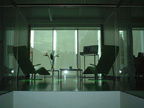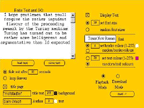:: Sunday, February 15, 2004 ::
Fix of the Week: [teleportacia.org]
 ORIGINAL POST: Tue Feb 03, 12:07:11 PM
ORIGINAL POST: Tue Feb 03, 12:07:11 PM BY: Eduardo Navas
Carlo Zanni claims to have successfully sold a net art work as an art gallery object. Altar boy, in essence, is a computer server that can function as a sculpture in the gallery that when connected to the net offers access to net projects developed by the artist. Zanni is interested in specific questions on art as a private and/or public sphere:
-Is it possible to sell networked based artworks? (net art)
-If yes, in which form?
-Is it possible to sell directly the Files instead of just a visualization of them?
-If I want to buy a net_project, what I buy?
-How can I buy something "public"?
-How can the concept of property merge with the sharing one?
How successful this attempt at commercializing net art will be is hard to tell at this point, but what should be noticed is the honest interest by Zanni to market a medium that, to this day, has proven to be a bit hard to sell through commercial galleries. And while artists have a tendency to crititique the market in which they function, Zanni is embracing the possibility of full-on commodification of net art, while also claiming a critical position. How critical such position is becomes the real question.
ORIGINAL POST: Tue Feb 03, 01:21:47 PM
BY: Peter Luining
In addition to Eduardo Navas's mail [above] about Zanni who claims to have sold a net art work as an art gallery object. I want to repost here part of an email I sent last week to nettime as a response to Cornelia Sollfrank's message that a work of her was purchased by one of Germany's most important private collections "the Sammlung Volksfuersorge".
Cornelia> Net Art as Collectors' Object -
Cornelia> How Smart Artists Make the Machine do the Work
Cornelia> With the purchase of artist Cornelia Sollfrank's net.art generator
Cornelia> 'nag_04', the Sammlung Volksfursorge becomes a pioneering art collector.
In the first place congrats. What I always understood is that being bought by important collectors or into a private collection is the highest recognition that a German artist can get. And it's interesting to know that also private collectors in Germany start to begin to develop interest in net art.
Below some history (that is far from complete) about net art as collector's object that could be of interest for anybody who's interested in this subject.
Since 1998, first netart gallery art by Olia Lialina. http://art.teleportacia.org The work "If You Want to Clean Your Screen" was in 1999 sold to entropy8zuper and can be found on their site: http://www.entropy8zuper.org/
possession/
Since 2000, artcart.de a German based net art gallery that sells amongst others net art works of artists like Valery Grancher, Blank & Jeron and Heath Bunting. They do artfairs like Art Frankfurt and did collaborate with galleries like Haines Gallery (San Francisco, USA).
http://www.artcart.de
In 2001 Doron Golan started to buy and collect net art works and put them on his site Computer Fine Arts. Since 2003 the computerfinearts net collection is permanently hosted by The Rose Goldsen Archive of New Media Art.
http://www.computerfinearts.com
In 2002 the Guggenheim (New York) aquires Mark Napier's work net.flag and John Simon's Unfolding Object.
http://www.guggenheim.org/
internetart/welcome.html
After my response net artist Valery Grancher sent me the following list of some other net art purchases:
-1998 La Fondation Cartier pour l'art Contemporain (Paris) bought my net art piece "self"
-1999 La Fondation Cartier pour l'art Contemporain (Paris) bought my net art piece 'Longitude 38': http://www.fondation.cartier.fr/
projet_web/long38/
-2000: Reina Sofia Museum Madrid bought Igor stromajer piece
-2003: Le musee d'art moderne centre georges pompidou bought Igor stromajer net art piece
-2003: Le musee d'art moderne centre georges pompidou bought Calin Man net art piece
For the record:
Through net art gallery artcart.de I sold up till now 17 works. 14 x the work titled 6.382.514.297 3x the work titled 6.210.041.345. For both works I used a shareware strategy. Read all about it in this announcer from 24 march 2000 to nettime-bold.
 ORIGINAL POST: Fri Jan 23, 01:20:51 PM
ORIGINAL POST: Fri Jan 23, 01:20:51 PMBY: Garrett Lynch
The GooglePoweredGoggleBox is the latest offering from Sam Woolf who I reviewed last November (18/11/03) for his Generative SoundTracker. Sam is one of many people floating around a lesser known gathering of people working from southern England under the guise of Blip (sci / art forum). Regularly meeting, showing and discussion new media art works the group is...
"a discussion group and forum for people interested in new forms of art that explore ideas about interaction, emergence, generative and procedural processes, teleprescence and artificial life. We aim to make this as wide and open a forum as possible and hope that this becomes a place where all types of artists and scientists can come to meet, collaborate, seek inspiration, and show off their latest work."
Sam Woolf's piece, the GooglePoweredGoggleBox is, like his last work, a generative application that produces linear content. This time the application focuses on producing videos, rather than soundtracks to videos as before, and it does this by assembling images compiled through a keyword search of Google's image search function that it then manipulates.
Now while we have the obvious scenario that this is a generative work and we can make connections between it and the work of Brian Eno etc. etc. What's more interesting is that this is an artwork that produces art works. The linear video art works it produces reflect the state of the network at any one time as composed / compiled collectively by it mass of users and could be said to be artefact's indicating social / cultural / economic trends as experienced by the heavily digitized western world. The application itself, by being placed in the 'art' (without a doubt networked) domain becomes a dada'esque collection of process's to producing art, a software manifesto of sorts that is in itself art.
Sam Woolf's applications are truly software art at it best. De-mystifying art as an elitist form, enabling the viewer to relate / understand / contextualize the work as a totality and then use the work to create their own art, it breaks down barriers between art / form and viewer (or user here) to only further new media art as a truly independent and ground breaking practice.